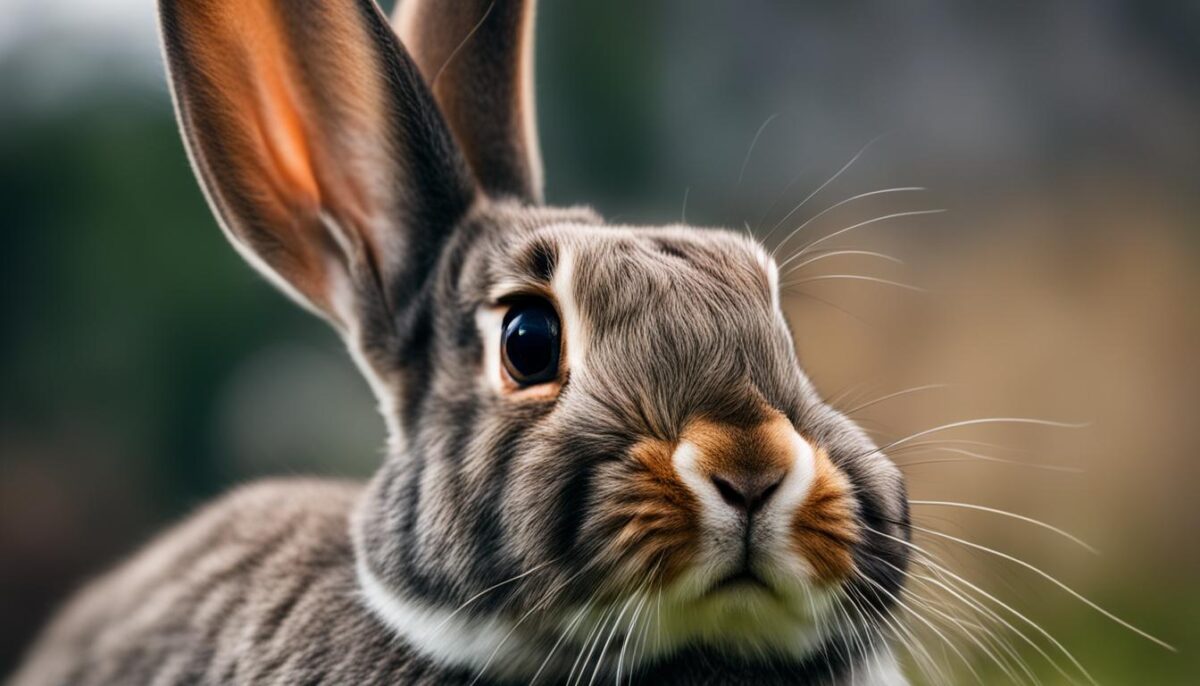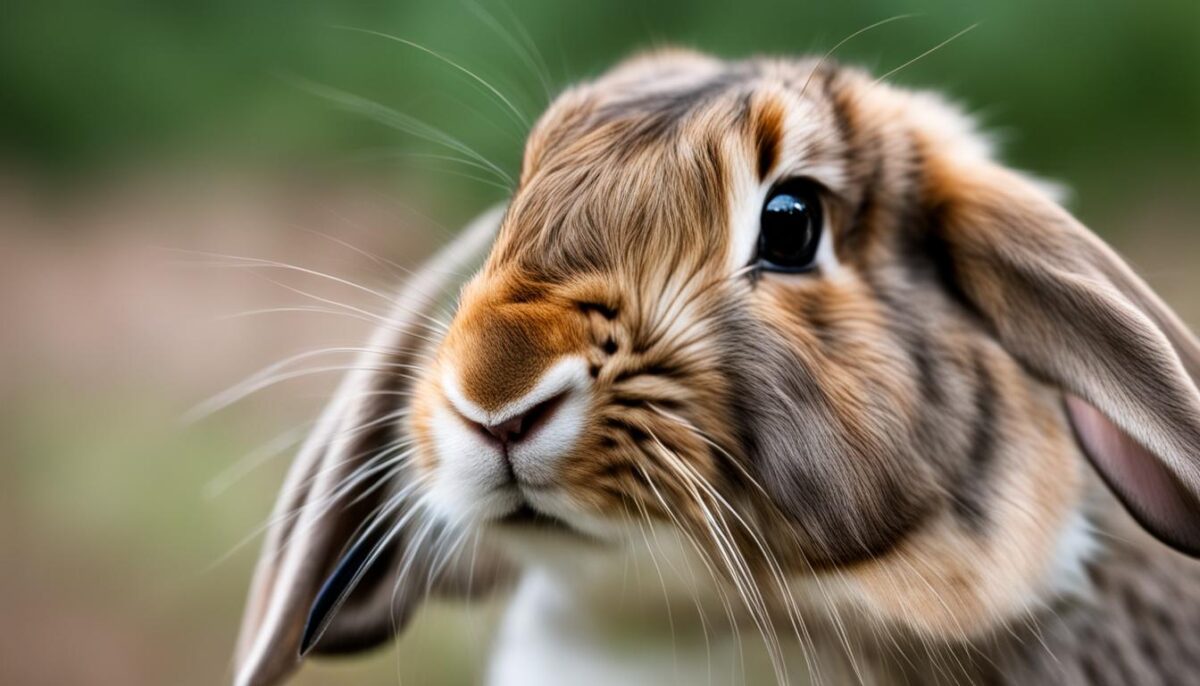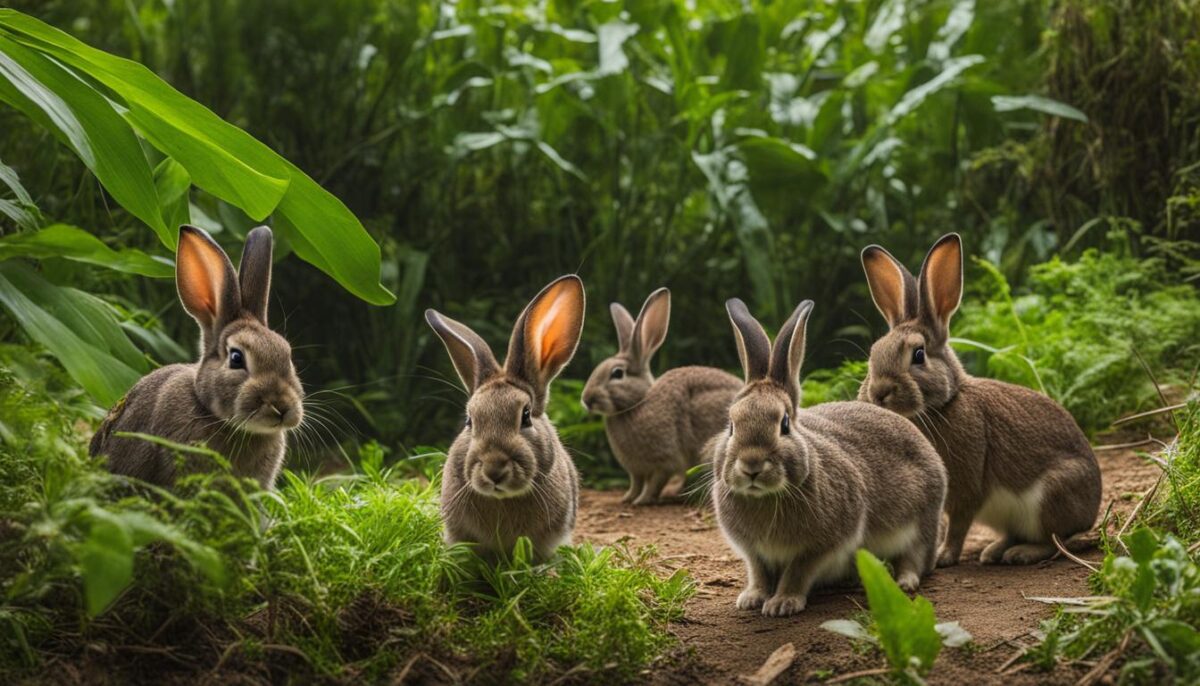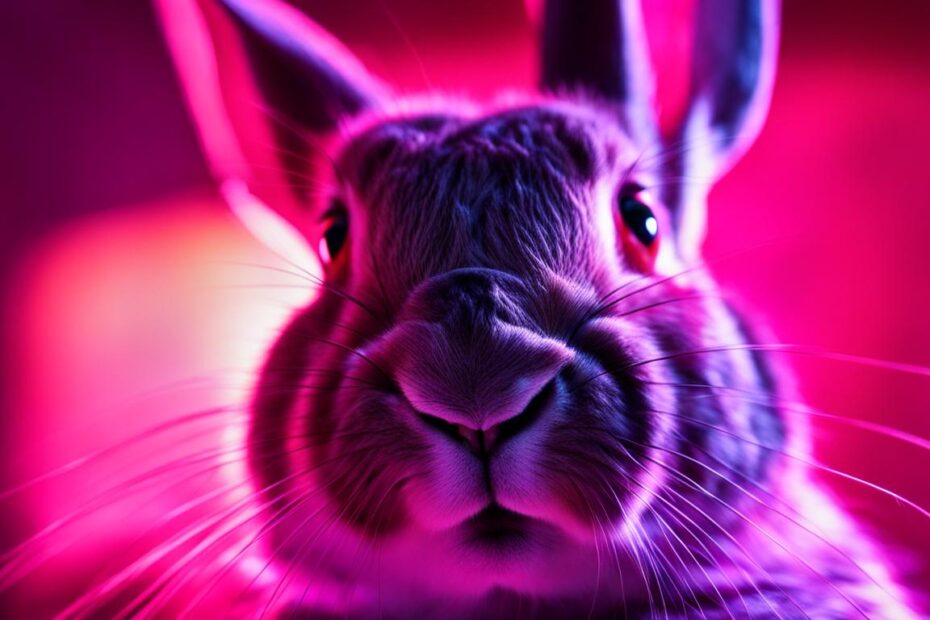Rabbits have the incredible ability to regulate their body temperature through their ears. If you’ve ever noticed that your rabbit’s ears feel unusually warm, you may be wondering what it means. In this article, we will explore the various states and emotions that a rabbit can communicate through their ear positions, helping you better understand your furry friend.
Key Takeaways:
- Rabbit ears serve as a means of communication and can indicate different emotions and states of being.
- Ears forward signify alertness and interest, while ears up and tilted indicate attentiveness and listening.
- Curiosity and playfulness can be shown through sideways ears, whereas ears down and back may indicate submissiveness or feeling threatened.
- Extreme fear or aggression is expressed through ears pulled back and flat against the head.
- Observing ear positions is important for understanding a rabbit’s well-being, behavior, and potential health issues.
Ears Forward – Alertness and Interest
When a rabbit’s ears are forward, it signifies their attentiveness and curiosity towards something directly in front of them. It shows their heightened hearing ability, confidence, and desire to not miss anything important. This ear position is often associated with a happy and relaxed rabbit who is ready to see what’s happening around them.
Rabbits have an incredible sense of hearing, and their ears play a crucial role in their ability to detect sounds. When a rabbit’s ears are hot and positioned forward, it indicates that they are focused on something specific in their environment. They may be listening for any signs of danger or simply showing their curiosity towards an interesting stimulus.
It is important for rabbit owners to pay attention to their rabbit’s ear positions, as it can provide valuable insights into their behavior and well-being. When a rabbit’s ears are forward, it is a good indication that they are feeling comfortable and engaged with their surroundings. By creating a safe and enriching environment, rabbit owners can encourage their rabbits to exhibit this alert and curious ear position.
Ears Up and Tilted – Alertness and Listening
When a rabbit’s ears are up and tilted, it indicates that they are paying attention and closely listening to their surroundings. This ear position shows a rabbit’s focus, alertness, and readiness to react to any potential changes or threats. With their ears raised, rabbits can capture even the faintest sounds, allowing them to stay vigilant and aware of their environment.
As prey animals, rabbits rely heavily on their acute hearing to detect potential dangers. By positioning their ears in an upright and tilted position, they maximize their ability to pick up on sounds from all directions. This helps them stay one step ahead of any predators or disturbances that may be present.
It’s important to note that a rabbit with its ears up and tilted may also be expressing curiosity towards something specific. They might be intrigued by a new sound or scent, prompting them to direct their full attention towards investigating its source. In these moments, their whole body becomes focused on uncovering the mystery, displaying their natural curiosity and intelligence.
Rabbit Ears Position Chart:
| Ear Position | Meaning |
|---|---|
| Ears Forward | Alertness and Interest |
| Ears Up and Tilted | Alertness and Listening |
| Sideways Ears | Curiosity or Playfulness |
| Ears Down and Back | Submissiveness or Feeling Threatened |
| Ears Back and Flat | Extreme Fear or Aggression |

“The rabbit’s ears are a remarkable asset, finely tuned to detect any shifts or disturbances in their surroundings. With their ears up and tilted, rabbits exhibit their acute listening skills, always ready to respond to potential threats or investigate new sounds.”
Sideways Ears – Curiosity or Playfulness
When a rabbit’s ears are positioned to the sides, it can indicate curiosity or playfulness. This ear position shows that the rabbit is intrigued by something new in their environment and is actively exploring and investigating. It can also indicate contentment and relaxation.
Rabbits have a natural curiosity and are known for their playful nature. When their ears are sideways, it’s a clear sign that they are engaged with their surroundings and are ready to interact with objects or other animals. This ear position often accompanies behaviors such as hopping around, nudging objects with their nose, or even engaging in playful activities with their owners.
It’s important for rabbit owners to encourage and provide opportunities for play and exploration, as it helps keep rabbits mentally stimulated and physically active. Providing toys, tunnels, and safe spaces for them to explore and investigate can greatly enhance their overall well-being and happiness. It’s also important to note that not all sideways ear positions indicate playfulness, as rabbits can also adopt this position when they are relaxed and content.
Sideways Ears – Curiosity vs. Playfulness
While sideways ears generally indicate curiosity or playfulness, it’s essential to assess other aspects of a rabbit’s behavior and body language to determine their specific state. A rabbit with curiosity may exhibit other signs such as sniffing, pawing, or reaching out towards the object of interest. On the other hand, a playful rabbit may engage in binkies (joyful jumps and twists in the air) or exhibit zoomies (quick bursts of running or chasing behavior).
Observing the context and the overall behavior of the rabbit will help provide a deeper understanding of whether they are curious or playful. It’s important to create a safe and enriching environment where rabbits can engage in their natural behaviors and express their curiosity and playfulness freely. This will not only enhance their quality of life but also strengthen the bond between rabbits and their owners.
| Ears Position | Meaning |
|---|---|
| Forward | Alertness and interest |
| Up and Tilted | Alertness and listening |
| Sideways | Curiosity or playfulness |
| Down and Back | Submissiveness or feeling threatened |
| Back and Flat | Extreme fear or aggression |
Ears Down and Back – Submissiveness or Feeling Threatened
When a rabbit’s ears are down and back, it can indicate submissiveness or feeling threatened. This ear position is their way of avoiding conflict and showing deference. It is important to respect their boundaries and create a stress-free environment.
However, rabbits can also exhibit this ear position when they are scared or feeling threatened. Other signals and body language should be taken into consideration to understand their true emotional state.
Observing a rabbit’s ear position in conjunction with their overall behavior and body language can provide valuable insights into their well-being and emotional state. If a rabbit consistently displays this ear position along with signs of stress or fear, it is important to reassess their environment, identify any potential stressors, and make necessary adjustments to ensure their comfort and safety.
Creating a calm and secure environment for rabbits is essential to their overall health and well-being. Providing them with a quiet space, plenty of hiding spots, and regular opportunities for mental and physical stimulation can help alleviate stress and promote a sense of security.
Table: Rabbit Ear Positions and Meanings
| Ear Position | Meaning |
|---|---|
| Ears Forward | Alertness and interest |
| Ears Up and Tilted | Alertness and listening |
| Sideways Ears | Curiosity or playfulness |
| Ears Down and Back | Submissiveness or feeling threatened |
| Ears Back and Flat | Extreme fear or aggression |
Understanding these different ear positions can help rabbit owners better interpret their rabbit’s behavior and emotional state, enabling them to provide appropriate care and support. It’s important to remember that each rabbit is unique, and individual body language cues should be taken into consideration alongside ear positions to fully understand a rabbit’s communication.
Ears Back and Flat – Extreme Fear or Aggression
When a rabbit’s ears are pulled back and flattened against the head, it can indicate extreme fear or aggression. This ear position is a clear sign that the rabbit is feeling very scared or angry. It is important to approach with caution and give the rabbit space when exhibiting this ear position.
In a state of extreme fear, a rabbit may feel threatened and may display defensive behaviors such as growling or lunging. It is crucial to avoid any sudden movements or loud noises that may further escalate the rabbit’s fear or aggression. Providing a calm and quiet environment can help the rabbit feel safe and reduce their anxiety.
“When a rabbit’s ears are pulled back and flat against their head, it’s a clear indication that they are feeling threatened and should be given space and time to calm down.”
It is important to remember that a rabbit exhibiting this ear position is not being aggressive or fearful intentionally, but rather reacting instinctively to a perceived threat. By understanding and respecting their body language, we can ensure the well-being and safety of both the rabbit and ourselves.
| Ear Position | Meaning |
|---|---|
| Ears forward | Alertness and curiosity |
| Ears up and tilted | Listening and focus |
| Sideways ears | Curiosity or playfulness |
| Ears down and back | Submissiveness or feeling threatened |
| Ears back and flat | Extreme fear or aggression |
Observing a rabbit’s ear positions can provide valuable insights into their emotions and behavior. By understanding and responding appropriately to their ear positions, we can establish trust and create a positive environment for our furry friends.

Heat Regulation and Other Ear Features
Rabbit ears serve multiple purposes, one of which is heat regulation. Rabbits have the ability to adjust the position of their ears to release excess heat in hot weather and retain warmth in colder temperatures. This is due to the high concentration of blood vessels in their ears, which allow for efficient heat exchange with the environment. By positioning their ears in different ways, rabbits can control the amount of heat dissipated or retained, helping them maintain a comfortable body temperature.
Additionally, the size and shape of a rabbit’s ears can vary based on their species and habitat. Some rabbits have longer ears, such as the lop-eared breed, which serve as an advantage for improved hearing. The longer ears provide a larger surface area for sound collection and help rabbits detect potential predators or food sources from a greater distance. On the other hand, rabbits living in colder climates may have shorter ears to minimize heat loss and conserve body heat.
Ears and Communication
It’s important to note that rabbit ears also play a significant role in communication. In addition to adjusting their ear positions for heat regulation, rabbits use their ears to convey their emotions and intentions to other rabbits and their human caregivers. For example, when a rabbit’s ears are relaxed and in a neutral position, it usually indicates a content and comfortable state. However, the position of the ears can quickly change in response to different stimuli or situations.
“The position of a rabbit’s ears can provide valuable insights into their emotional state and overall well-being,” says Dr. Jane Carter, a veterinarian specializing in rabbit health. “As rabbit owners, it’s important to observe their ear positions along with other body language cues to better understand their needs and ensure their health and happiness.”
| Ear Position | Meaning |
|---|---|
| Ears Forward | Alertness and interest |
| Ears Up and Tilted | Listening and attentiveness |
| Sideways Ears | Curiosity or playfulness |
| Ears Down and Back | Submissiveness or feeling threatened |
| Ears Back and Flat | Extreme fear or aggression |
By paying attention to the position of their rabbit’s ears and understanding the associated meanings, rabbit owners can better communicate and bond with their furry companions. Observing their ear positions, along with other behavioral cues, can provide valuable insights into a rabbit’s health, emotions, and overall well-being. If there are any sudden or consistent changes in their ear positions, it’s important to consult a veterinarian who specializes in rabbit health to ensure prompt and appropriate care.

Conservation Efforts for Native Rabbit Species
The survival of native rabbit species is of utmost importance due to the critical role they play in maintaining the balance and biodiversity of ecosystems. However, several native rabbit species, such as the New England cottontail, are currently facing habitat loss and are on the edge of extinction. To combat this alarming trend, dedicated conservation efforts are being implemented to reintroduce these rabbits back into their natural habitats.
Conservation initiatives for native rabbit species involve a combination of captive breeding programs and reintroduction strategies. In captivity, rabbits are bred under controlled conditions to ensure genetic diversity and prevent inbreeding. Once mature, these rabbits are released into carefully selected habitats that offer suitable resources and protection.
These efforts are not only limited to releasing rabbits into the wild but also include habitat restoration projects. By restoring and creating suitable habitats, conservationists aim to provide the necessary resources for native rabbit species to thrive once reintroduced. This includes planting native vegetation, managing invasive species, and protecting important ecological corridors.
Table: Conservation Efforts for Native Rabbit Species
| Conservation Method | Description |
|---|---|
| Captive Breeding | Rabbits are bred in captivity to ensure genetic diversity and prevent inbreeding. This helps maintain healthy populations for reintroduction. |
| Reintroduction Programs | Mature rabbits from captive breeding programs are released into carefully selected habitats. This allows them to reestablish wild populations. |
| Habitat Restoration | Efforts to restore and create suitable habitats for native rabbit species. This includes planting native vegetation and managing invasive species. |
| Ecological Corridor Protection | Conservationists work to protect and maintain important ecological corridors that allow rabbits to move between habitats and ensure their long-term survival. |
These conservation efforts require collaboration among government agencies, non-profit organizations, and local communities. Public awareness and education play a crucial role in garnering support and fostering a sense of responsibility towards protecting native rabbit species.

By investing in the conservation of native rabbit species, we can preserve these unique animals for future generations and help maintain the delicate balance of our natural ecosystems.
Conclusion
Rabbit ears play a significant role in their communication and can provide valuable insights into their emotions and well-being. By understanding the different positions of rabbit ears, owners can better care for their furry friends.
Observing rabbit ear positions, along with overall body language and behavior, can help detect any potential health issues. Sudden changes in ear position may indicate underlying problems, and it is crucial to seek veterinary attention if abnormalities are observed.
In addition to rabbit care, native rabbit species are also facing challenges. Habitat loss and population decline threaten the survival of species like the New England cottontail. Conservation efforts, such as captive breeding and habitat restoration, are pivotal in protecting and preserving these important members of our ecosystems.
In conclusion, understanding rabbit ears enhances our ability to care for these incredible creatures. By paying attention to their ear positions, we can ensure their well-being and contribute to the conservation of native rabbit species. Let’s appreciate and protect these furry friends who bring joy and vitality to our lives.
FAQ
Why do rabbits have the ability to regulate their body temperature through their ears?
Rabbits have a unique circulatory system that allows them to transfer heat to their ears, helping them cool down in hot weather and retain warmth in cold weather.
What does it mean when a rabbit’s ears are forward?
When a rabbit’s ears are forward, it signifies their attentiveness and curiosity towards something directly in front of them. It shows their heightened hearing ability, confidence, and desire to not miss anything important.
What does it mean when a rabbit’s ears are up and tilted?
When a rabbit’s ears are up and tilted, it indicates that they are paying attention and closely listening to their surroundings. This ear position shows a rabbit’s focus, alertness, and readiness to react to any potential changes or threats.
What does it mean when a rabbit’s ears are positioned to the sides?
When a rabbit’s ears are positioned to the sides, it can indicate curiosity or playfulness. This ear position shows that the rabbit is intrigued by something new in their environment and is actively exploring and investigating. It can also indicate contentment and relaxation.
What does it mean when a rabbit’s ears are down and back?
When a rabbit’s ears are down and back, it can indicate submissiveness or feeling threatened. This ear position is their way of avoiding conflict and showing deference. However, rabbits can also exhibit this ear position when they are scared or feeling threatened. Other signals and body language should be taken into consideration to understand their true emotional state.
What does it mean when a rabbit’s ears are pulled back and flattened against the head?
When a rabbit’s ears are pulled back and flattened against the head, it can indicate extreme fear or aggression. This ear position is a clear sign that the rabbit is feeling very scared or angry. It is important to approach with caution and give the rabbit space when exhibiting this ear position.
How do rabbit ears help with heat regulation?
Rabbit ears serve as a means of releasing excess heat in hot weather and retaining warmth in colder temperatures. Rabbits have the ability to adjust the position of their ears to regulate their body temperature.
Why is it important to observe a rabbit’s ear positions?
By paying attention to a rabbit’s ear positions, along with their overall body language and behavior, owners can gain valuable insights into their rabbit’s health, emotions, and overall state of well-being. Sudden changes in ear position can also be a sign of health issues that may need veterinary attention.
What conservation efforts are being made for native rabbit species?
Some native rabbit species, such as the New England cottontail, are facing habitat loss and population decline. Conservation efforts involve captive breeding and releasing rabbits back into their natural habitats to preserve biodiversity and prevent extinction.
How can understanding rabbit ear positions benefit rabbit owners?
Understanding the meanings behind different ear positions can help rabbit owners better understand their rabbit’s behavior and overall well-being. It allows them to provide proper care and create a stress-free environment for their rabbits.


